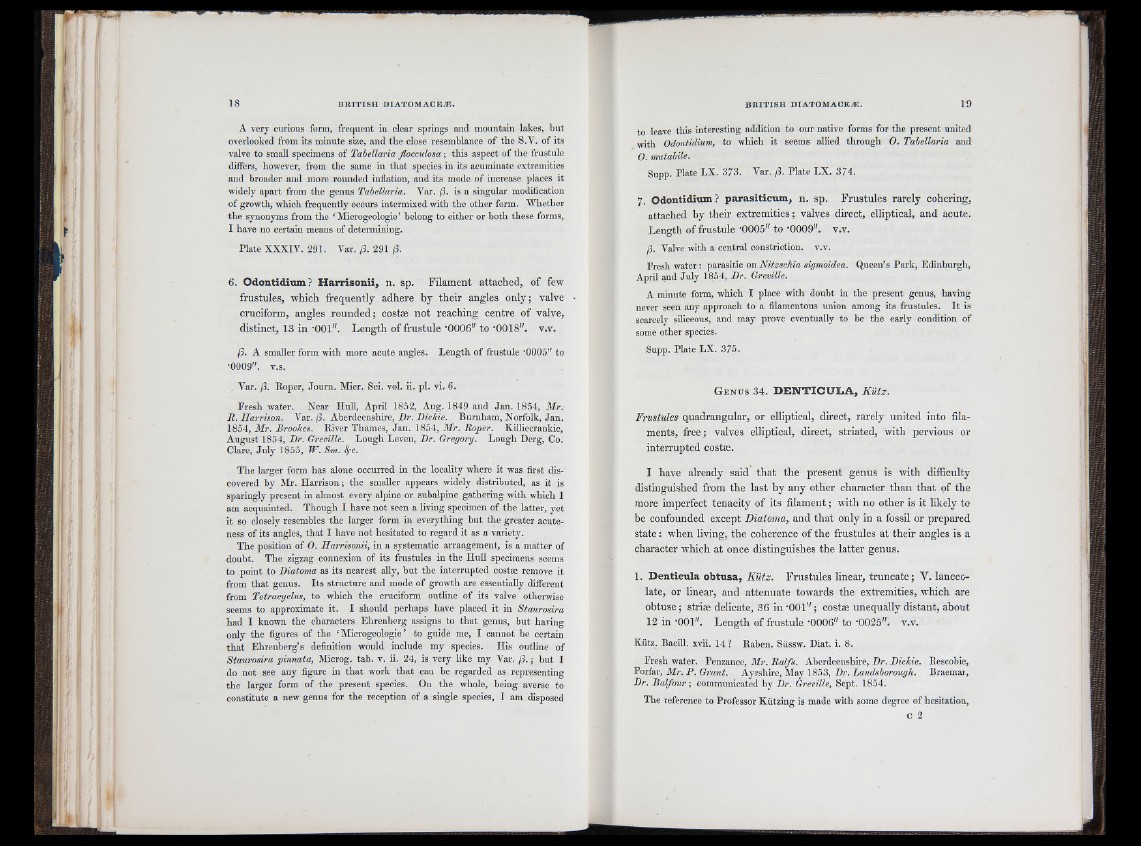
A very curious form, frequent in clear springs and mountain lakes, but
overlooked from its minute size, and tbe close resemblance of the S.V. of its
valve to small specimens of Tabellaria flocculosa ; this aspect of the frustule
differs, however, from the same in tliat species in its acuminate extremities
and broader and move rounded inflation, and its mode of increase places it
widely apart from the genus Tabellaria. Var. fi. is a singular modification
of growth, which frequently occurs intermixed with the other form. Whether
the synonyms from the ‘Microgeologie’ belong to either or both these forms,
I have no certain means of determining.
Plate XXXIV. 291. Var. /?. 291 ¡3.
6 . Odontidium? Harrisouii, n. sp. Filament attached, of few
frustules, which frequently adhere hy their angles only; valve
cruciform, angles rounded; costæ not reaching centre of valve,
distinct, 13 in 'OOl". Length of frustule -0006" to 'OOIS". v.v.
ß. A smaller form with more acute angles.
Length of frustule -0005" to
•0009". v.s.
Var. (3. Roper, Journ. Micr. Sci. vol. ii. pi. vi. 6.
Fresh water. Near Hull, April 1852, Aug. 1849 and Jan. 1854, Mr.
B. Harrison. Var. ¡3. Aberdeenshire, Dr. Dickie. Burnham, Norfolk, Jan.
1854, Mr. Brookes. River Thames, Jan. 1854, Mr. Roper. Killiecrankie,
August 1854, Dr. Greville. Lough Leven, Dr. Gregory. Lough Derg, Co.
Clare, July 1855, W. Sm. Sfc.
The larger form has alone occurred in the locality where it was first discovered
by Mr. Harrison ; the smaller appears widely distributed, as it is
sparingly present in almost every alpine or subalpine gathering with which I
am acquainted. Though I have not seen a living specimen of the latter, yet
it so closely resembles the larger form in everything but the greater acuteness
of its angles, that I have not hesitated to regard it as a variety.
The position of O. Harrisonii, in a systematic arrangement, is a matter of
doubt. The zigzag connexion of its frustules in the Hull specimens seems
to point to Diatoma as its nearest ally, but the interrupted costæ remove it
from that genus. Its structure and mode of growth are essentially different
from Tetraeyclus, to which the cruciform outline of its valve otherwise
seems to approximate it. I should perhaps have placed it in Staurosira
had I known the characters Ehrenberg assigns to that genus, but having
only the figures of the ‘Microgeologie’ to guide me, I cannot he certain
that Ehrenherg’s definition would include my species. His outline of
Staurosira pinnata, Microg. tab. v. ii. 24, is very like my Var, fi. ; but I
do not see any figure in that work that can be regarded as representing
the larger form of the present species. On the whole, being averse to
constitute a new genus for the reception of a single species, I am disposed
to leave this interesting addition to our native forms for the present united
with Odontidium, to wliich it seems allied through 0. Tabellaria and
0. mutabile.
Supp. Plate LX. 373. Var. ¡3. Plate LX. 374.
7. O d o n tid ium ? p a r a s itic um , n. sp. Frustules rarely cohering,
attached by their extremities; valves direct, elliptical, and acute.
Length of frustule -0005" to -0009". v.v.
(3. Valve with a central constriction, v.v.
Fresh water: parasitic on Nitsschia sigmoidea. Queen’s Park, Edinburgh,
April and July 1854, Dr. Greville.
A minute form, which I place with doubt in the present genus, having
never seen any approach to a filamentous union among its frustules. It is
scarcely siliceous, and may prove eventually to be the early condition of
some other species.
Supp. Plate LX. 375.
G e n ü s 34. D E N T IC U L A , Kütz.
Frustules quadrangular, or elliptical, direct, rarely united into filaments,
free; valves elliptical, direct, striated, with pervious or
interrupted costæ.
I have already said that the present genus is with difficulty
distinguished from the last by any other character than that of the
more imperfect tenacity of its filament ; with no other is it likely to
be confounded except Diatoma, and that only in a fossil or prepared
state : when living, the coherence of the frustules at their angles is a
character which at once distinguishes the latter genus.
1. Denticula obtnsa, Kütz. Frustules linear, truncate ; V. lanceolate,
or linear, and attenuate towards the extremities, which are
obtuse; striæ delicate, 36 in '001''; costæ unequally distant, about
12 in -001". Length of frustule -0006" to -0025". v.v.
Kiitz. Bacill. xvii. 14 ? Raben. Sfissw. Diat. i. 8.
Fresh water. Penzance, Mr. Ralfs. Aberdeenshire, Dr. Dickie. Bescobie,
Forfar, Mr. P. Grant. Ayrshire, May 1853, Dr. Landsborough. Braemai,
Dr. Balfour-, communicated by Dr. Greville, Sept. 1854.
The reference to Professor Kützing is made with some degree of hesitation,
C 2